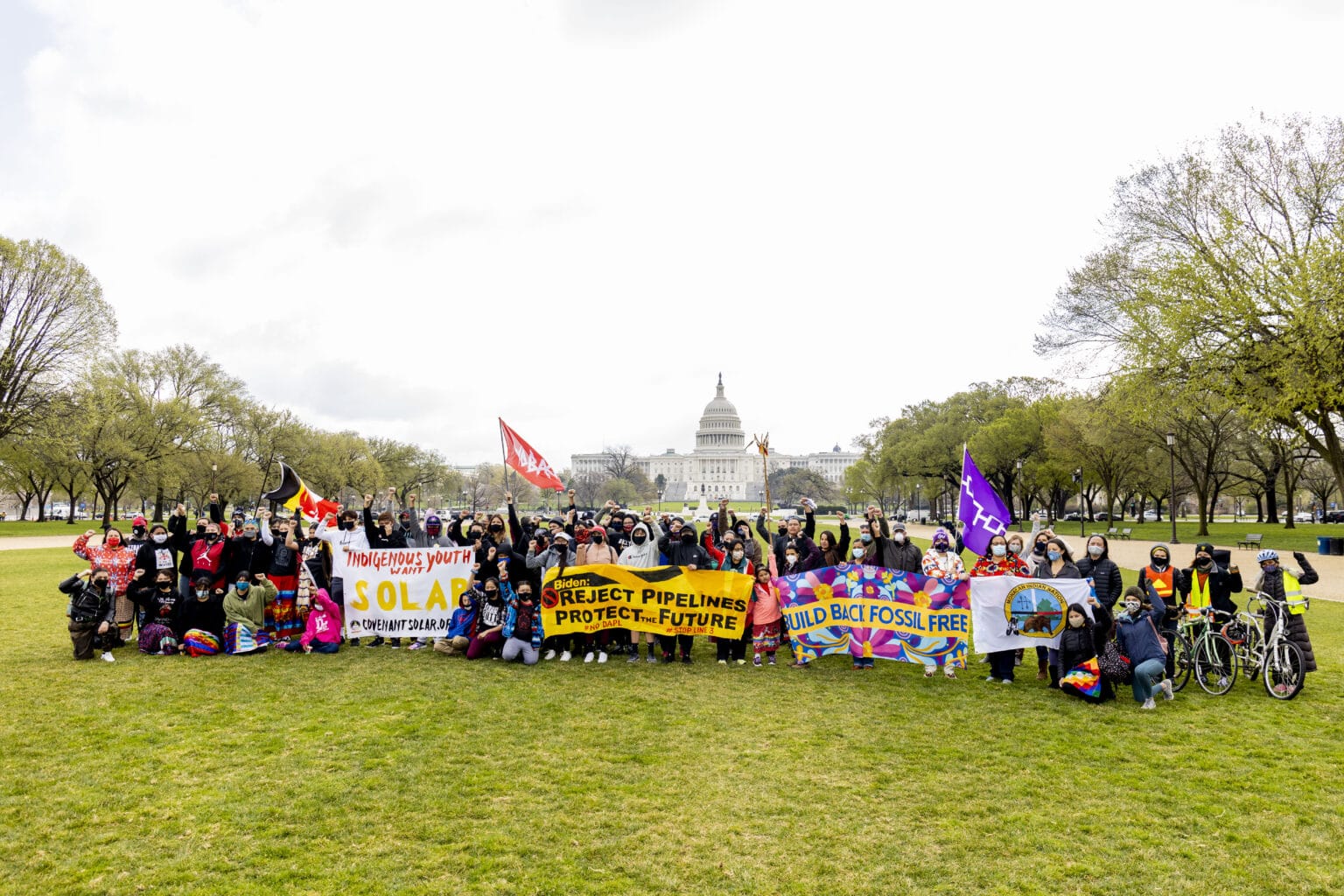On March 31, President Joe Biden unveiled the blueprint for a $2.25 trillion infrastructure package, which would include enormous investments in renewable energy, electric vehicles, and public transit, along with roads, bridges, and water infrastructure. The White House is billing it as a “generational investment” that will lead to “transformational progress in our ability to tackle climate change.”
But a day later, Indigenous youth and organizers opposing the Line 3 and Dakota Access pipelines rallied in front of the White House against the two fossil fuel pipelines. They also delivered a petition with 400,000 signatures to the U.S. Army Corps of Engineers, calling for the cancelation of both projects, and for the Biden administration to “Build Back Fossil Free” while fulfilling promises on climate action, Indigenous rights, and environmental justice.
The White House remains silent on both of the pipeline projects. The Dakota Access pipeline carries Bakken oil from North Dakota across the heart of the North American continent to Illinois, ultimately connecting into a larger network that allows oil to flow to the Gulf Coast. The Line 3 project is a new pipeline aimed at replacing and expanding an aging pipeline, carrying Canadian tar sands oil from Alberta to Superior, Wisconsin.
Indigenous communities say both projects pose oil spill risks, are blatant cases of racism and injustice, and the two pipelines are high-profile examples of deception and coercion on behalf of the fossil fuel industry.
Indigenous youth rallied in Washington, D.C. on April 1 to demand the halting of both projects. But more broadly they called on the Biden administration to pursue aggressive climate action. The size and scope of Biden’s infrastructure package will be debated in Congress in the coming weeks, but it is likely shaping up to be the Biden administration’s most significant pathway for addressing the climate crisis in his first term.
In a statement, the Indigenous Environmental Network (IEN) recognized the importance of Biden’s infrastructure proposal, but said it has a “major oversight: it neither acknowledges nor strengthens tribal sovereignty.” Biden’s infrastructure bill should put Indigenous communities at the heart of economic recovery, the group said. There is a long history of the U.S. government violating treaties it signed with Indigenous nations, and at the same time, Tribes opposed to the two pipelines are on the frontlines for potential oil spills and other safety hazards.
IEN urged the Biden administration to consider a much more ambitious proposal put forward in February by a group of progressives in Congress — a $10 trillion package that would amount to a more dramatic acceleration of a clean energy transition, and one that calls for protections for Native American treaty rights and tribal sovereignty.
“Congress and the Biden administration must know that recovery cannot take place until Tribal nations are the ones making the decisions about projects that impact their peoples and their lands,” IEN stated. With this sweeping infrastructure proposal, President Biden is attempting to address the overlapping economic and climate crises, but for any “meaningful and long-lasting recovery” to take place, the plan also needs to address “all inequitable impediments blocking the way of the secure economies of Tribal Nations and communities,” IEN added.
Critical Moment for Line 3
The anti-pipeline rallies led by Indigenous youth in Washington, D.C. on April 1 included a “die-in” where protesters lay on the ground in a moment of silence to symbolize the death wrought by the pipelines and the climate crisis. Activists also held aloft a 200-foot-long “black snake,” a reference to a Lakota prophecy about a black snake desecrating sacred lands. In this case, the black snake is meant to symbolize an oil pipeline and its threat to Indigenous communities. Together, the activists marched through the streets of D.C. in a slithering fashion back and forth, carrying the snake above their heads.
Today, communities fighting Line 3 / DAPL / KXL / MVP / Line 5 just:
— Dallas Goldtooth (@dallasgoldtooth) April 1, 2021
• Hand delivered 100ks of signatures to the US army corps
• Marched a 300ft black snake thru DC.
• Blocked streets w/ tripods in front of WH.
To say @POTUS #BuildBackFossilFree #ShutdownDAPL #StopLine3 pic.twitter.com/5usux7DhUH
The oil pipelines are viewed as an immediate threat to tribal sovereignty and to the climate, and the administration has key legal questions to make in the coming weeks regarding the fate of both projects. Through the Army Corps of Engineers, the administration could potentially impose delays or pull the plug on both.
Enbridge, the owner of Line 3, is taking a two-month pause on construction beginning on April 1, but the project is roughly 50 percent complete and is slated to reach completion later this year. The Dakota Access pipeline is already online, although it too faces legal questions regarding its ongoing operation.
Water is Life! @POTUS pls stop these tarsands oil pipeline expansion projects that threaten the ground water supply, drinking water for rural communities + tribal reservations, in Northern MN? We should not be forced to drink or eat foods from oil contaminated water. #StopLine3 https://t.co/AUPK1zXmkM
— Honor the Earth (@HonorTheEarth) April 2, 2021
While under construction in 2016, the Dakota Access pipeline involved a violent crackdown, which resulted in police and private security using water cannons and attack dogs to violently remove water protectors in Cannon Ball, North Dakota, to clear the way for construction to proceed.
But the Line 3 pipeline has taken a different tack. Enbridge has tried to gain support from some Tribes with monetary incentives, paying some Tribes undisclosed sums as well as the promise of jobs and job training. Enbridge then points to that tribal support to make the case that it has support from all Indigenous communities.
It’s a deceptive tactic used by the fossil fuel industry to conceal environmental destruction and avoid accountability, according to a new report from the NAACP which details several ways in which the industry tries to deflect accountability. As the report notes, one of the methods identified was “Co-opt Community Leaders and Organizations and Misrepresent the Interests and Opinions of Communities.” The NAACP says that co-opting through deceptive alliances with local organizations, at times with financial support, can “neutralize or weaken public opposition.”
Climate journalist Emily Atkin who writes the Heated newsletter recently reported that Enbridge has been running ads in local newspapers for years, promoting its “unprecedented level of Tribal engagement.”
At the same time, however, Atkin reported that Enbridge is paying Minnesota police for tactical gear, gas masks, and “Safety Patrol,” ostensibly to ensure the mostly women-led Indigenous resistance does not disrupt the construction schedule. Indigenous water protectors have been arrested for tree-sitting and other direct actions intended to halt construction.
“Enbridge has demonstrated ongoing respect for tribal sovereignty,” Juli Kellner, a spokesperson for Enbridge, wrote to DeSmog in an email. “The Line 3 Replacement Project included a first-of-its kind Tribal Cultural Resource Survey led by the Fond du Lac Band of Lake Superior Chippewa.” Kellner also noted that the Leech Lake Band and the Fond du Lac Band of Lake Superior Chippewa have spoken in support of key permits.
When asked about this statement, Tara Houska, an attorney and citizen of the Couchiching First Nation in Ontario, and founder of Giniw Collective, an Indigenous women–led frontline resistance group, said in a text message to DeSmog: “All of that respect must be why 3 Ojibwe nations are suing against approval of Enbridge’s pipeline.” She added: “Every impacted nation should’ve been part of the cultural survey.” Houska was born and raised in northern Minnesota.
Indian Country Today has detailed the ways in which Enbridge has lavished money on some Indigenous communities, pressuring them into signing on in support of the project. Through such tactics, Line 3 has created discord between different Tribes, Indian Country Today reported.
“Enbridge is a multi-national bully,” Houska told DeSmog. “We deal with divided communities. We deal with the uptick in violence and other ills man camps bring.” Studies have shown that the presence of temporary housing for oil workers, often groups of trailers or “man camps,” is associated with increased violence against Indigenous women. Since Line 3 began construction in December, there have been reports of incidents of alleged assaults by Enbridge workers, according to the Minnesota Reformer. In February, two Enbridge workers were arrested in a human trafficking sting.
“Enbridge has done its best to paint local people concerned about our land and environment as outside protesters or anti-jobs,” Houska added. “In reality, we are community people who have to deal with the impacts of fossil fuel expansion and tar sands spills once Enbridge packs up and the temporary jobs are gone, just like everyone else who lives here.
Last week, Beltrami/Hubbard County sheriffs arrested 26 water protectors with @GiniwCollective, including @zhaabowekwe.
— Honor the Earth (@HonorTheEarth) March 30, 2021
Officers kenneled, strip-searched, and held them overnight on misdemeanor charges.@POTUS cannot remain silent. He must #StopLine3 https://t.co/x3wNt5MJlQ
Biden Under Pressure
The White House is describing the infrastructure proposal as a vehicle for climate action. And while some progressive environmental groups view the infrastructure package as a good start, they say it lacks ambition. “If it’s passed, this plan would be the largest investment the federal government has made to address social and economic crises in fifty years,” the Sunrise Movement said in reaction. “Still, this plan is nowhere near enough to meaningfully combat the climate crisis or transform our society and economy.”
The Indigenous Environment Network says that Biden should instead consider the Transform, Heal, and Renew by Investing in a Vibrant Economy (THRIVE) Act, a sweeping piece of legislation that calls for economic, environmental, Indigenous, and racial justice introduced by progressives in both the House and Senate, including Senators Ed Markey (D-MA), Elizabeth Warren (D-MA), as well as some considered more towards the center of the political spectrum, such as Majority Leader Chuck Schumer (D-NY). Biden’s plan, for instance, calls for $2.25 trillion in spending over 10 years while the THRIVE Act calls for $10 trillion, or $1 trillion per year.
Importantly, the THRIVE Act also contains specific calls for recognizing treaty rights for Indigenous nations, and requiring Free, Prior, and Informed Consent of Tribes on issues affecting them.
During their rally, Indigenous youth called on Biden and the Army Corps of Engineers to revoke permits for both Line 3 and Dakota Access. They have yet to hear a response.
WATCH:
— Indigenous Environmental Network (@IENearth) April 2, 2021
Frontline Indigenous youth & organizers from impacted Dakota Access, Line 3, KXL, Line 5 and Mountain Valley pipeline communities ran through D.C. demanding @JoeBiden #ShutdownDAPL and #StopLine3.
We can't wait any longer. #buildbackfossilfree
Video by:
Aleksei Wagner pic.twitter.com/IYRrWasnYM
Gina McCarthy, Biden’s White House National Climate Advisor, tweeted out her support for opponents of Line 3 last year when she was leading the Natural Resources Defense Council. She too has been silent on the project since joining the new administration.
I’m proud to join Indigenous leaders and climate advocates in urging @GovTimWalz to oppose Enbridge’s Line 3 tar sands pipeline and protect Minnesotans’ health, water, and land.
— Gina McCarthy (@GinaNRDC) August 13, 2020
The time for dangerous oil pipelines is over. Read our letter to #StopLine3: https://t.co/HK2F7utI4v
The successful completion and continued operation of both the Dakota Access and Line 3 pipelines is not inevitable. Multiple legal issues bedevil both projects, and the Biden administration has a chance to stop them.
On the one hand, Line 3 has cleared many legal hurdles, but it still faces some outstanding issues at the state level. The Mille Lacs Band of Ojibwe, the Red Lake Nation, and the White Earth Nation, along with advocacy groups Honor the Earth and the Sierra Club are suing Minnesota’s approval of environmental permits.
Another avenue pipeline opponents are pursuing is to challenge the permit issued by the Army Corps of Engineers in federal court.
Meanwhile, the Dakota Access pipeline, which is already operating, is also vulnerable. In July 2020, the U.S. District Court for the District of Columbia ruled that the U.S. Army Corps of Engineers violated federal environmental law when it issued a permit for the pipeline in the early days of the Trump administration. The pipeline is now operating without a federal easement, and the court has tasked the Army Corps — now under the Biden administration — to come up with a better justification for granting the easement or to shut it down. The Army Corps is scheduled to return to court on April 9 to explain its next steps.
On both pipelines, the Army Corps of Engineers has a great deal of leverage. While Biden has avoided taking action thus far, with key permit decisions pending, his administration will soon need to weigh in one way or the other.
For pipeline opponents, however, the choice is clear. “We want good paying jobs that don’t require us to destroy our own backyards and contaminate the water,” Tara Houska told DeSmog. “We want our kids to hunt, fish, and do all of the things that make rural Northern Minnesota so special.”
Subscribe to our newsletter
Stay up to date with DeSmog news and alerts







